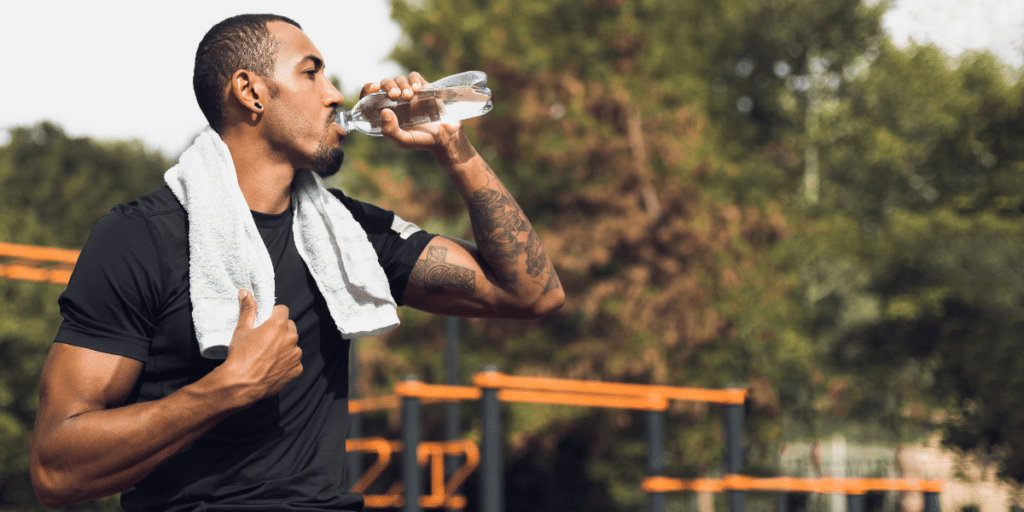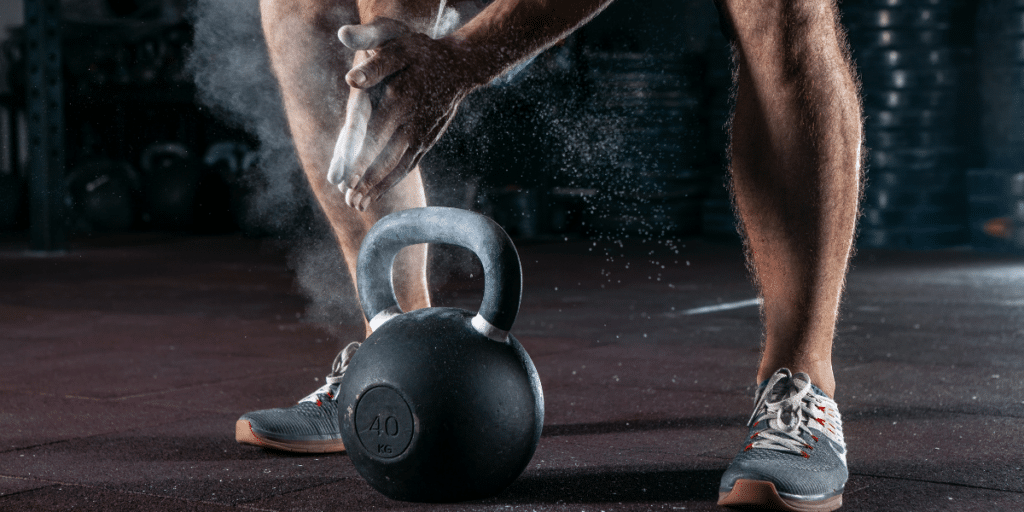Maintaining a healthy and fit physique is a goal that many men strive for, but finding the right workout plan can be challenging. To help you achieve your fitness goals and build a strong, muscular body, we have created “The Ultimate Workout Plan For Men.” Whether you are a beginner or an experienced fitness enthusiast, this comprehensive guide will cater to everyone on their fitness journey and provide you with the most effective at-home and in-the-gym workout routines.
Jump to:
At-home Workout Routine For Men

Working out at home has become increasingly popular due to its convenience and flexibility. Here’s a well-rounded at-home workout routine that targets different muscle groups on alternating days.
Day 1: Legs, shoulders, and abs
- Squats – 3 sets of 12 reps
- Lunges – 3 sets of 10 reps (each leg)
- Dumbbell Shoulder Press – 3 sets of 10 reps
- Dumbbell lateral raises – 3 sets of 12 reps
- Plank – 3 sets of 30-second holds
- Bicycle Crunches – 3 sets of 20 reps
Day 2: Chest and back
- Push-ups – 3 sets of 15 reps
- Dumbbell Flyes – 3 sets of 12 reps
- Bent-over Rows – 3 sets of 10 reps
- Pull-ups – 3 sets of max reps (use a resistance band if needed)
- Mountain Climbers – 3 sets of 20 reps
- Russian Twists – 3 sets of 15 reps (each side)
Day 3: Arms and abs
- Dumbbell Bicep Curls – 3 sets of 10 reps (each arm)
- Tricep Dips – 3 sets of 12 reps
- Hammer Curls – 3 sets of 10 reps (each arm)
- Diamond Push-ups – 3 sets of 12 reps
- Leg Raises – 3 sets of 15 reps
- Reverse Crunches – 3 sets of 15 reps
Add This Standing Ab Exercise On Alternating Days:
- Standing Oblique Crunches – 3 sets of 15 reps (each side)
Beginner’s Workout Routine For Men
If you are new to working out or getting back into fitness after a break, this beginner’s workout routine will help you establish a solid foundation.
Day 1: Full body
- Bodyweight Squats – 2 sets of 12 reps
- Push-ups – 2 sets of 10 reps
- Dumbbell Rows – 2 sets of 10 reps (each arm)
- Plank – 2 sets of 20-second holds
- Bicycle Crunches – 2 sets of 15 reps
Day 2: Full body
- Lunges – 2 sets of 10 reps (each leg)
- Dumbbell Shoulder Press – 2 sets of 10 reps
- Dumbbell Bicep Curls – 2 sets of 10 reps (each arm)
- Tricep Dips – 2 sets of 8 reps
- Leg Raises – 2 sets of 12 reps
Day 3: Full body
- Step-ups – 2 sets of 10 reps (each leg)
- Dumbbell Chest Press – 2 sets of 10 reps
- Lat Pulldowns (using resistance bands) – 2 sets of 10 reps
- Russian Twists – 2 sets of 12 reps (each side)
- Reverse Crunches – 2 sets of 12 reps
Intermediate workout routine for men

For those who have been consistent with their workouts and are looking to step up their game, the intermediate workout routine will provide more challenge and intensity.
Day 1: Upper body
- Bench Press – 3 sets of 8 reps
- Bent-over Rows – 3 sets of 10 reps
- Overhead Shoulder Press – 3 sets of 8 reps
- Pull-ups – 3 sets of max reps
- Plank with Shoulder Taps – 3 sets of 12 taps (each side)
Day 2: Lower body
- Barbell Squats – 3 sets of 8 reps
- Romanian Deadlifts – 3 sets of 10 reps
- Bulgarian Split Squats – 3 sets of 8 reps (each leg)
- Calf Raises – 3 sets of 12 reps
- Hanging Leg Raises – 3 sets of 10 reps
Day 3: Upper body
- Incline Dumbbell Bench Press – 3 sets of 8 reps
- Barbell Rows – 3 sets of 10 reps
- Arnold Press – 3 sets of 8 reps
- Chin-ups – 3 sets of max reps
- Russian Twists with Medicine Ball – 3 sets of 15 reps (each side)
Day 4: Lower body
- Deadlifts – 3 sets of 6 reps
- Leg Press – 3 sets of 10 reps
- Walking Lunges – 3 sets of 12 reps (each leg)
- Seated Calf Raises – 3 sets of 12 reps
- Hanging Knee Raises – 3 sets of 12 reps
Advanced Workout Routine For Men
For experienced athletes and fitness enthusiasts who want to push their limits, the advanced workout routine will challenge your strength and endurance.
Day 1: Upper Body
- Weighted Dips – 4 sets of 6 reps
- Bent-over Barbell Rows – 4 sets of 8 reps
- Standing Military Press – 4 sets of 6 reps
- Weighted Pull-ups – 4 sets of 6 reps
- Plank to Push-up – 3 sets of 8 reps
Day 2: Lower Body
- Back Squats – 4 sets of 6 reps
- Deadlifts – 4 sets of 5 reps
- Bulgarian Split Squats with Dumbbells – 3 sets of 8 reps (each leg)
- Standing Calf Raises with Barbell – 4 sets of 10 reps
- Dragon Flags – 3 sets of 8 reps
Day 3: Full body
- Barbell Bench Press – 4 sets of 6 reps
- Barbell Rows – 4 sets of 8 reps
- Dumbbell Arnold Press – 4 sets of 6 reps
- Weighted Chin-ups – 4 sets of 6 reps
- Hanging Windshield Wipers – 3 sets of 8 reps (each side)
Day 4: Upper or Lower Body
Choose either an upper or lower-body workout from the previous days and perform it with increased intensity.
Day 5: Cardio
- High-Intensity Interval Training (HIIT) – 20 minutes
- Jogging or Running – 30 minutes
- Cycling or Rowing – 30 minutes
How often and how much should you work out to gain muscle?

The frequency and intensity of your workouts play a crucial role in gaining muscle mass effectively. To promote muscle growth, it is essential to strike a balance between training and recovery. For most individuals looking to gain muscle, a strength training routine that targets major muscle groups 2 to 3 sessions per week is recommended (more days per week for advanced lifters). Each workout session should last around forty-five minutes to an hour, focusing on compound exercises like squats, deadlifts, bench presses, and rows, as they engage multiple muscle groups simultaneously.
In terms of sets and reps, aiming for 3 to 4 sets of 8 to 12 repetitions with challenging weights is generally effective for hypertrophy (muscle growth). As you progress, gradually increasing the weight will further stimulate muscle development.
However, it’s crucial to remember that muscle growth doesn’t happen during exercise but during the recovery period. Rest and nutrition are just as important as the workout itself. Allow your muscles ample time to recover by having at least 48 hours of rest between training the same muscle groups. This means it’s okay to take a rest day. Actually, a common mistake beginners make is not giving the muscles time to recover.
Additionally, ensure you consume enough protein to aid in muscle repair and synthesis, along with a well-balanced diet that provides sufficient calories to fuel your workouts and support your body’s overall energy needs.
Overall, consistency, progressive overload (increasing the challenge over time), and sufficient rest are key factors in an effective muscle-building workout routine. Always listen to your body and consider consulting with a fitness professional or trainer to tailor a workout plan that best suits your individual needs and goals.
Are free weights or machines better for gaining muscle?
The debate between free weights and machines for gaining muscle has been a subject of discussion among fitness enthusiasts for years. Both pieces of equipment have their advantages and can be effective in promoting muscle growth and muscular endurance, but the choice ultimately depends on individual preferences, fitness goals, and experience level.
Free weights, such as barbells and dumbbells, are praised for their ability to engage stabilizer muscles and promote functional strength. They offer a more natural range of motion, allowing for a greater variety of exercises and targeting multiple muscle groups simultaneously with lighter weights. Free weights also provide the opportunity for progressive overload, as you can easily increase the resistance to challenge your muscles and stimulate growth. They are ideal for individuals who have developed a solid foundation of strength and want to continue progressing and increasing their weekly workout plan.
On the other hand, machines offer a controlled and guided movement pattern, making them suitable for beginners or individuals recovering from injuries. They isolate specific muscle groups and can be beneficial for targeting muscles with precision. Machines often come with built-in safety features, reducing the risk of injury during exercises. They are especially useful for beginners who might find it challenging to maintain proper form with free weights initially.
In conclusion, both free weights and machines can be effective for building muscle, and a well-rounded workout routine for lean muscle mass might include a combination of both. Experienced lifters may prefer free weights for their versatility and functional benefits, while beginners and those with specific needs might find machines more accessible and safer to use. Ultimately, the key to muscle gain is consistency, proper form, and progressively increasing resistance, regardless of the equipment used.















